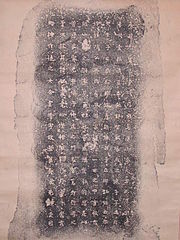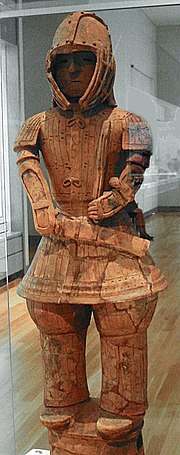Selected lists
| This page is currently inactive and is retained for historical reference. Either the page is no longer relevant or consensus on its purpose has become unclear. To revive discussion, seek broader input via a forum such as the village pump. |

The term "National Treasure" has been used in Japan to denote cultural properties since 1897. The definition and the criteria have changed since the inception of the term. The structures in this list of shrines designated as National Treasures of Japan are eligible for government grants for repairs, maintenance and the installation of fire-prevention facilities and other disaster prevention systems. Owners are required to announce any changes to the National Treasures such as damage or loss and need to obtain a permit for transfer of ownership or intended repairs. The practice of marking sacred areas began in Japan as early as the Yayoi period (from about 500 BC to 300 AD) originating from primal religious beliefs. Features in the landscape such as rocks, waterfalls, islands, and especially mountains, were places believed to be capable of attracting kami, and subsequently were worshiped as yorishiro. Originally, sacred places may have been simply marked with a surrounding fence and an entrance gate or torii. Later, temporary structures similar to present day portable shrines were constructed to welcome the gods to the sacred place, which eventually evolved into permanent buildings that were dedicated to the gods. Ancient shrines were constructed according to the style of dwellings (Izumo Taisha) or storehouses (Ise Grand Shrine). The buildings had gabled roofs, raised floors, plank walls, and were thatched with reed or covered with hinoki cypress bark. Such early shrines did not include a space for worship. Three important forms of ancient shrine architectural styles exist: taisha-zukuri, shinmei-zukuri and sumiyoshi-zukuri. They are exemplified by Izumo Taisha, Nishina Shinmei Shrine and Sumiyoshi Taisha, respectively, and date from before 552 AD. According to the tradition of Shikinen sengū-sai (式年遷宮祭), the buildings or shrines were faithfully rebuilt at regular intervals adhering to the original design. In this manner, ancient styles have been replicated through the centuries to the present day.
Read more...| This page is currently inactive and is retained for historical reference. Either the page is no longer relevant or consensus on its purpose has become unclear. To revive discussion, seek broader input via a forum such as the village pump. |

The term "National Treasure" has been used in Japan to denote cultural properties since 1897. The definition and the criteria have changed since the inception of the term. The writings in this list of documents designated as National Treasures of Japan contains items of various type such as letters, diaries, records or catalogues, certificates, imperial decrees, testaments and maps. Writing was physically introduced to Japan from China in the form of inscribed artefacts around the year 1 BC. Examples, some of which have been designated as archaeological national treasures, include coins of the reign of Wang Mang (AD 8–25), a 1st century gold seal from Shikanoshima, a late 2nd century iron sword from the Tōdaijiyama burial mound, the Seven-Branched Sword with inscription from 369 and a large number of bronze mirrors—the oldest dating to the 3rd century. All of these artifacts originated on the continent, most likely in China. The concept of writing came to Japan from the Korean kingdom of Baekje in the form of classical Chinese books likely written on paper and in the form of manuscript rolls. The oldest texts of Japanese origin, which show a clear understanding of the concept of writing, date to the 5th century and are inscriptions on stone or metal.
Examples include three archaeological National Treasures: Suda Hachiman Shrine Mirror from about the 5th century, which is a poor copy of a Chinese original, the Inariyama Sword from 471 or 531 and the Eta Funayama burial mound sword from about the 5th century. The abrupt transition from an unfamiliarity with writing to reading and writing complicated works in a foreign language required the earliest Japanese texts be composed and read by people from the continent such as Wani. The Inariyama Sword is also the oldest example of man'yōgana use, a writing system that employs Chinese characters to represent the Japanese language. Soon after the introduction of writing, scribes were appointed to the provinces to "record events and report conditions".
Read more...| This page is currently inactive and is retained for historical reference. Either the page is no longer relevant or consensus on its purpose has become unclear. To revive discussion, seek broader input via a forum such as the village pump. |

The term "National Treasure" has been used in Japan to denote cultural properties since 1897. The definition and the criteria have changed since the inception of the term. The weapons in this list of swords designated as National Treasures of Japan span from the late Kofun to the Muromachi period.
During the Yayoi period from about 300 BC to 300 AD, iron tools and weapons such as knives, axes, swords or spears, were introduced to Japan from Korea and China. Shortly after this event, Chinese, Korean, and eventually Japanese swordsmiths produced ironwork locally. Swords were forged to imitate Chinese blades: generally straight chokutō with faulty tempering. Worn slung from the waist, they were likely used as stabbing and slashing weapons. Swordmaking centers developed in Yamato, San'in and Mutsu where various types of blades such as tsurugi, tōsu and tachi were produced.
Flat double-edged (hira-zukuri) blades originated in the Kofun period, and around the mid-Kofun period swords evolved from thrusting to cutting weapons. Ancient swords were also religious objects according to the 8th century chronicles Nihon Shoki and Kojiki. In fact, one of the Imperial Regalia of Japan is a sword, and swords have been discovered in ancient tumuli or handed down as treasures of Shinto shrines or Buddhist temples. Few ancient blades (jokotō) exist because the iron has been corroded by humidity. The transition from straight jokotō or chokutō to deliberately curved, and much more refined Japanese swords (nihontō), occurred gradually over a long period of time, although few extant swords from the transition period exist.
Read more...| This page is currently inactive and is retained for historical reference. Either the page is no longer relevant or consensus on its purpose has become unclear. To revive discussion, seek broader input via a forum such as the village pump. |

The term "National Treasure" has been used in Japan to denote cultural properties since 1897. The definition and the criteria have changed since the inception of the term. The weapons in this list of archaeological materials designated as National Treasures of Japan span a period from about 4,500 BC to 1361 AD. The Japanese Paleolithic marks the beginning of human habitation in Japan. It is generally accepted that human settlement did not occur before 38,000 BC. Archaeological artifacts from the paleolithic era consist of stone tools of various types. From about 14,000 to 8,000 BC, the society gradually transformed to one characterized by the creation of pottery used for storage, cooking, bone burial and possibly ceremonial purposes. Dogū—small clay figurines depicting humans and animals—can be dated to the earliest Jōmon period but their prevalence increased dramatically in the middle Jōmon. Three dogū from 3000 to 1000 BC have been designated as National Treasures. The ensuing Yayoi period is characterized by great technological advances such as wet-rice agriculture or bronze and iron casting, which were introduced from the mainland. Iron knives and axes, followed by bronze swords, spears and mirrors, were brought to Japan from Korea and China. The primary artistic artifacts, with the exception of Yayoi pottery, are bronze weapons, such as swords, halberds and dōtaku, ritual bells. In addition ornamental jewels were found. The starting date of the Kofun period (c. 250–300 AD) is defined by the appearance of large-scale keyhole-shaped kofun mound tombs, thought to mark imperial burials. Typical burial goods include mirrors, beads, Korean Sue ware, weapons and later horse gear. Mirrors, swords and curved jewels, which constitute the Imperial Regalia of Japan, appear as early as the middle Yayoi period, and are abundant in Kofun period tombs. Characteristic of most kofun are haniwa clay terra cotta figures whose origin and purpose is unknown. A haniwa of an armoured man has been designated as National Treasure; and a 1st-century gold seal, designated a National Treasure, shows one of the earliest mentions of Japan or Wa.
Read more...Portal:Ancient Japan/Selected lists/5
Portal:Ancient Japan/Selected lists/6
Portal:Ancient Japan/Selected lists/7
Portal:Ancient Japan/Selected lists/8
Portal:Ancient Japan/Selected lists/9
Portal:Ancient Japan/Selected lists/10